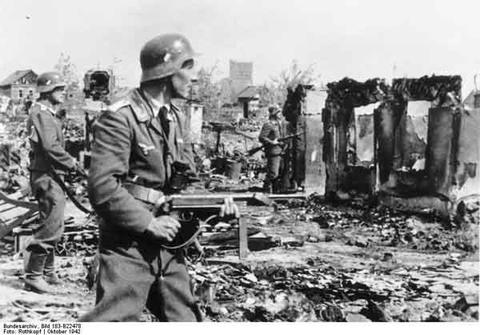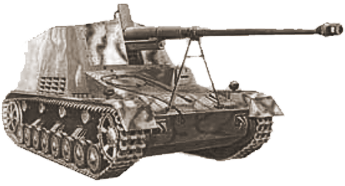Sixth Army's Flanks Outside Stalingrad: The Southern Sector

Over the past month we have looked at four major Soviet offensives launched against the German Sixth Army's northern flank as it attempted to clear the Soviet 62nd Army from Stalingrad (pictured in the image to the right). In particular, the Red Army's First Kotluban offensive had an enormous impact on events inside the city. As bad as the Second through Fourth Kotluban offensive's went for the Soviet Don Front's army's they also would impact not only the fighting within Stalingrad, but the German perception of the threat to Sixth Army posed by Army Group B's overextended front.
However, as crucial as those events were one could argue that what happened on Sixth Army's southern flank was even more important. To understand why we need to examine the two offensive's launched by the Stalingrad Front in October of 1942 and directed against the German forces in and just outside Stalingrad's southern boundary. Northwest of Stalingrad, and as the Don Front's 1st Guards, 24th, and 66th Army's pounded away at the German XIV Panzer Corps during the Second Kotluban offensive Stavka also ordered the Stalingrad Front to attack Sixth Army's forces south of the city. These attacks, led by the Soviet 51st, 57th, and 64th Army's, also sought to take German pressure off Chuikov's 62nd Army, then fighting for its life within Stalingrad proper.
Unlike the assaults on the northern flanks, which ran into dug in German strongpoints backed by strong armored reserves, on the night of September 28-29, 1942 the weight of the Soviet offensive fell on the Romanian 1st and 4th Infantry Divisions defending a huge front in the lake region 60-75 kilometers south of Stalingrad. The Soviet shock groupings, led by Major General F.I.Tolbukhin's 57th Army, quickly penetrated and decimated the Romanian infantry divisions. Paulus was forced to dispatch the 14th Panzer Division and 29th Motorized Division (both from the XXXXVIII Panzer Corps) to counter-attack. The German armor stablized the front, albeit further west than it had been. However, for the better part of two weeks the 14th Panzer Division would be unavailable for the crucial assault on Stalingrad's Factory District.
What's more, on the night of October 1-2 the Soviet 64th Army hit the German 371st Infantry Division north of the former Romanian positions. This attack would fail, providing the most important lesson to yet emerge from the entire series of Soviet attacks immediately northwest and south of Stalingrad. That being, when the Soviet army's struck dug-in German troops they never succeeded in accomplishing their goals. In contrast, the Romanian divisions could not hold up against similar Soviet attacks. A point further driven home on October 25, 1942.
By mid-October of 1942 Eremenko was once again drawing up plans to take pressure off Chuikov's 62nd Army. To that end the Stalingrad Front's 64th Army was directed to prepare another assault against the Axis forces, this time attacking Fourth Panzer Army's troops in Stalingrad's southern suburbs. The Soviet axis of attack would fall once more on the German 371st Infantry Division (backed by the 71st Infantry Division and 29th Motorized Division). The Soviet 64th Army, led by Lieutenant General M.S. Shumilov, gathered 30,000 men, 80 tanks, 243 artillery pieces, 92 rocket launchers, and 180 aircraft for the attack. Facing this force was two regiments from the German 371st Infantry Division. Though grossly out-numbered the German troops were veteran soldiers dug into stout defensive positions. Regardless of the German experience Shumilov's army should have steamrolled the out-numbered and out-gunned German defenders, but when 64th Army's attack began on October 25th it went nowhere. After days of fruitless attacks the offensive was called off on November 2nd without even forcing the Germans to shift forces from their operations against 62nd Army.
The Germans rightly took comfort from the ability of a single infantry division to defeat the best efforts of an entire Soviet army. However, in focusing on the results of not only this attack but the four failed Soviet offensives north of Stalingrad in the Kotluban region, the Germans overlooked one important detail. The Soviet Stalingrad Front had crushed with ease the only Romanian infantry divisions it had struck. Moreover, these Romanian forces were forming a larger and larger presence on Sixth Army's flanks as the fighting in Stalingrad sucked up ever greater quantities of Sixth Army's dwindling manpower and resources.
This is not to denigrate the Romanian contribution to the war. During the Crimean and Caucuses campaign Romanian forces often fought well. However, each of those circumstances were unique in comparison to what was being asked of the Romanian's on the open steppe outside Stalingrad. There, their deficiencies in armored fighting vehicles and anti-tank weapons stood in contrast to the well-equipped German divisions. How hard would it have been for the Germans to assist Romanian industry in retooling factories to produce the quantity and quality of weapons needed to truly give their armed forces a chance at success? And before a reader says 'wait a second, Romania was nowhere near capable of cranking out Panzer IV's and Me-109's by the thousands' - they didn't have to do that much. Had the Romanian infantry deployed outside Stalingrad been even as well-equipped as their German allies in terms of automatic weapons, anti-tank guns, and indirect firepower like artillery and cheaply manufactured mortars or rockets it would have dramatically bolstered their defenise capabilities; even against Soviet armor. What many people forget is that even as late as the fall of 1942 nearly half the Red Army's tank park was composed of T-60 and T-70 light tanks that though dangerous against infantry and other soft targets were otherwise extremely vulnerable to anti-tank weaponry. Licensed built versions of German light machine-guns, mortars, medium artillery pieces, and the then standard 50mm anti-tank gun were all weapons Romanian industry could have easily cranked out in quantities needed by their armed forces. This had long been known of course, but the neglect in doing so was part and parcel of a German approach to war fighting that completely marginalized the benefits of incorporating allied forces into a true coalitional effort.
Stepping back, the larger take away from the repeated Soviet offensives launched against Sixth Army's flanks during the fall of 1942 is that dug-in German panzer, motorized, and infantry divisions had proven their defensive worth. However, the Germans overlooked the vulnerabilities posed by relying on inproperly equipped and supported Axis allies for flank security. On the other hand, the Red Army had accurately analzyed the reasons why their offensives had failed, having already made important adjustments that would produce decidedly different results less than three weeks later.



Post new comment